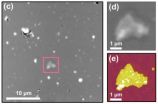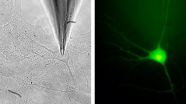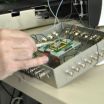(Press-News.org) Using a neutron beam as a probe, researchers working at the National Institute of Standards and Technology (NIST) have begun to reveal the crystal structure of a compound essential to technologies ranging from sonar to computer memory. Their recent work* provides long-sought insight into just how a widely used material of modern technology actually works.
The compound is a "piezoelectric," a material capable of changing one kind of energy into another—mechanical to electrical, or vice versa. Long employed in sonar systems to detect sound waves, more recently piezoelectrics have been applied in devices that require minuscule changes in position, such as the head that reads data from your computer's hard drive.
For decades, the industry standard piezoelectric has been PZT, a compound that contains titanium,zirconium, lead and oxygen. Crystals of PZT change a tiny fraction of a percent in size when a sound wave strikes them, and thisshape change creates an electrical impulse. Decades ago, it was discovered that PZT performs at its best when the titanium and zirconium appear in approximately equal proportions, but no one really understood why.
"The theories frequently concern what happens at the transition line between having a surplus of zirconium and one of titanium," says Peter Gehring of the NIST Center for Neutron Research (NCNR). "Some theories suggest that right near the transition zone, the atoms take on a special configuration that allows certain atoms to move more freely than they can otherwise. But because it's been hard to grow a crystal of PZT large enough to analyze, we couldn't completely test these ideas."
A breakthrough came when chemists at Canada's Simon Fraser University managed to grow single crystals of a few millimeters in size and sent them to the NCNR for examination with neutron scattering—a technique for determining the positions of individual atoms in a complex crystal structure by observing the patterns made by neutrons bouncing off it. The team, which also included researchers from the University of Oxford, the University of Tokyo, and the University of Warwick, was able to definitively rule out one of the proposed structures of PZT.
Instead, they found that each PZT crystal element likely assumes one of two possible forms that coexist within the larger crystal array. These forms are dictated by chemical composition, and they may influence how well the material performs on a large scale. Their findings also suggest that the change in behavior seen at the transition happens gradually, rather than at some sharply delineated proportion of zirconium to titanium.
Gehring says the results could be a step toward bettering PZT. "Determining the structure might give us the perspective necessary to design a piezoelectric material from first principles, instead of just playing around and seeing what works," he says. "That's what you need if you're ever going to build a better mousetrap."
INFORMATION:
* D. Phelan, X. Long, Y. Xie, Z.-G. Ye, A.M. Glazer, H. Yokota, P.A. Thomas and P.M. Gehring. Single crystal study of competing rhombohedral and monoclinic order in lead zirconate titanate. Physical Review Letters, Nov. 8, 2010, DOI: 10.1103/PhysRevLett.105.207601
END
VIDEO:
Wireless. For most, the word conjures images quaint coffee shops or busy airport lobbies -- places where people drop in to check on business or check in with other people.
But...
Click here for more information.
BEAUMONT – Wireless. For most, the word conjures images quaint coffee shops or busy airport lobbies – places where people drop in to check on business or check in with other people.
But increasingly "wireless" is showing up on the farm to help produce better ...
The researchers characterize their new technique as a neat solution to the "needle in a haystack" problem of nanoscale microscopy, but it's more like the difference between finding the coffee table in a darkened room either by walking around until you fall over it, or using a flashlight. In a new paper,* a group from JILA—a joint venture of the National Institute of Standards and Technology (NIST) and the University of Colorado—finds tiny assemblies of biomolecules for subsequent detailed imaging by combining precision laser optics with atomic force microscopy.
The ...
Neurons communicate via chemical transmitters which they store in the bubble-like synaptic vesicles and release as required. To be able to react reliably to stimulation, neurons must have a certain number of "acutely releasable" vesicles. With the help of a new method, neuroscientists at the Max Planck Institute of Experimental Medicine in Göttingen have now discovered that neurons systematically recycle the protein components necessary for transmitter release and in this way guarantee the reliability of signal transmission in the brain. If this process is disrupted, the ...
Montreal, November 10, 2010 – The initial findings of a survey on the prevalence of gambling in Quebec have been released. The study also deals with behavior problems associated with gambling. The study reveals that nearly 70 percent of Quebec adults report having bet or spent money on gambling during the previous 12 months. It also found Quebecers spend an average of $483 annually on gambling activities.
This survey was conducted between June and September 2009 throughout the province among 11,888 non-institutionalized adults over the age of 18. It constitutes the first ...
November 10, 2010 -- To keep soldiers in the battlefield healthy, the U.S. Army is exploring new ways to detect harmful bacteria in water.
Current techniques for analyzing water in the field can take as long as 24 hours to complete, according to Bart Lipkens of Western New England College in Springfield, Massachusetts and his colleagues at Physical Sciences in Andover, Ma.
They are working on an alternative technology that uses sound waves to accelerate the process.
"The goal of our project is to speed up the detection of bacteria in water supplies," said Lipkens. ...
The eye is not just a lens that takes pictures and converts them into electrical signals. As with all vertebrates, nerve cells in the human eye separate an image into different image channels once it has been projected onto the retina. This pre-sorted information is then transmitted to the brain as parallel image sequences. Scientists from the Max Planck Institute of Neurobiology in Martinsried have now discovered that fruit flies process optical information in a similar way. The evidence suggests that this type of wiring is an effective energy-saving mechanism and is therefore ...
Dogs have long been called man's best bomb detector –– until now.
A Tel Aviv University scientist leads a research team that has developed a powerful electronic sensor to detect multiple kinds of explosives –– including those used in the recent Yemeni bomb threat. Based on nanotechnology advances, the new sensor is small, portable, and is more sensitive and reliable at detecting explosives than any sniffer dog, says its lead researcher Prof. Fernando Patolsky of Tel Aviv University's Raymond and Beverly Sackler School of Chemistry.
With scientific findings on it published ...
CHAMPAIGN, Ill. — The Chrysler and General Motors bankruptcy reorganizations represented a sea change in corporate restructuring, one that could portend the end of our current system of bankruptcy reorganization, according to a published article by two University of Illinois experts in bankruptcy law.
Law professors Charles J. Tabb and Ralph Brubaker argue that the legal principles applied in the GM and Chrysler bankruptcies – two of the largest in U.S. history at $83.5 and $39.9 billion, respectively – were misguided, and ultimately have undermined the distributional ...
Manufacturer recalls of toys, promotional drinking glasses, and other children's products constitute an ongoing "toxic toys crisis" that requires banning potentially harmful ingredients in these products and other changes in policy and practices. That's the conclusion of a new analysis in ACS' Environmental Science & Technology, a semi-monthly journal.
Monica Becker, Sally Edwards and Rachel Massey note that in June the United States government recalled 12 million promotional drinking glasses sold at a fast-food restaurant chain because the painted coating contained ...
Snap an image of friends in front of a window curtain and the camera captures the people - and invisible blood stains splattered on the curtain during a murder. Sound unlikely? Chemists from the University of South Carolina are reporting development of a camera with that ability to see the invisible, and more. Called multimode imaging in the thermal infrared, the new technology could find uses in crime scene investigations and elsewhere, they say in a series of three reports in ACS' Analytical Chemistry, a semi-monthly journal.
Michael Myrick, Stephen Morgan and their ...





